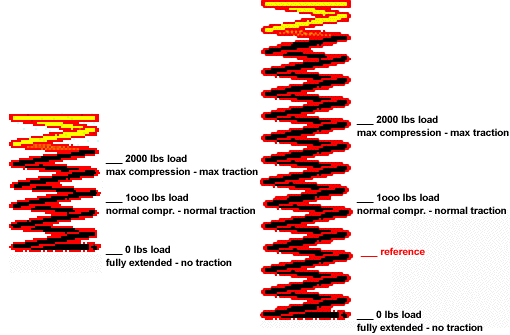© 1998-2010 H. Pietschmann
|
Longer springs are better for traction
(More wheel travel actually maintains traction longer)
Don't forget to read the big BUT... at bottom of page
| Let's assume a vehicle weighs 4,000 lbs - that means each tire is pressed down with 1,000 lbs.
A spring will expand when it supports less than 1/4 of the vehicle weight (ie when tire rolls into a small depression - visually moving down and out of the fender well). As a result the other spring on the same axle will have to take over the extra load, and compresses more (visually that tire will move up into the fender well).
Since the traction is defined by friction (between tire and ground) plus weight, traction will be less when a tire carries less weight. Because an expanded spring does not press a tire as hard onto the ground. Traction maximum is reached when a spring is fully compressed - the point of absolutely no traction is reached when a spring is fully extended.
Therefore it is fair to say, that short springs (little wheel travel, usually on vehicles with independent suspension) will make a vehicle lose traction sooner than long springs (plenty of wheel travel, usually on vehicles with live axles).
This explains why vehicles with plenty of wheel travel (Range Rover) maintain traction longer than vehicles with little wheel travel (M-Class). Unless some sort of traction management (diff locks or traction control, 4ETS, etc) is present, a vehicle with less wheel travel will be stuck while the one with more wheel travel is still driving.
|
 |
The longer spring in the picture above has more than twice the downtravel of the shorter spring. At the point where the short spring loses ground contact and traction completely (reference line) the longer spring still carries more than 500 lbs and still maintains half of its traction.
So, vehicles with longer wheel travel maintain sufficient traction longer - they will get stuck later than a car with marginal wheel travel. |
- BUT....
the simple fact that a wheel is still on the ground and has some amount of traction does not necessarily mean you can continue driving.
The wheel with less traction determines how much torque can be generated at an axle. The wheel with the increased traction will get the same amount of torque as the wheel with less taction before it starts spinning. So, if the combined amount of torque (double of what is possible at the wheel with less traction) is sufficient to move the truck - the truck moves (in a 4WD the amount of torque of the other axle is added of course).
If traction at the wheels with less traction is not high enough to create sufficient torque for movement, one or more wheels are starting to slip and spin - they are the ones with less traction and they are usually diagonally opposed
We would then say "I have lost traction" - which is not entirely correct since you have some traction, but not enough for the amount of torque needed to move the truck.
So, when Range Rover claims that a RR will not lose traction because it's wheels due to the long wheel travel almost never lose ground contact is correct. However, the fact that a wheel is still on the ground and has some traction does not mean the Rover is still moving.
If the amount of torque determined by the wheel(s) still in contact with the ground but with reduced traction, is not sufficient to move the car - it will be stuck.
So, not a wheel in the air gets you stuck, one or two wheels with insufficient traction will do the same thing.
|
Only traction management like 4ETS (Mercedes M-Class) or manual differential lockers (Mercedes G-Class)
will keep wheels from spinning and the vehicle moving. Congratulate yourself if you own either product.
Don't be fooled by wannabees.
Traction use of a 2WD - Traction use of a 4WD
Traction management in a turn with 2WD - Traction management in a turn with 4 WD
Need for more torque and traction management in a 2WD vs 4WD
| 4WD layouts | crawl ratio | 4WD components | |
